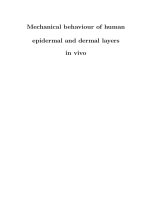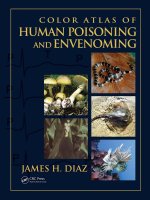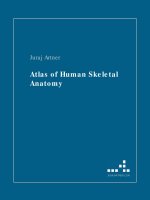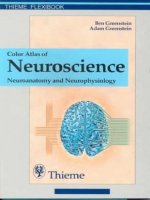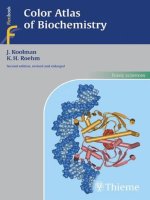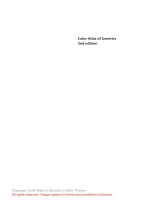diaz - color atlas of human poisoning and envenoming (crc, 2006)
Bạn đang xem bản rút gọn của tài liệu. Xem và tải ngay bản đầy đủ của tài liệu tại đây (12.89 MB, 558 trang )
HUMAN POISONING
AND ENVENOMING
COLOR ATLAS OF
221X_Book.indb 2 10/26/06 10:44:51 AM
CRC Press is an imprint of the
Taylor & Francis Group, an informa business
Boca Raton London New York
HUMAN POISONING
AND ENVENOMING
COLOR ATLAS OF
JAMES DIAZ
Published in 2006 by
CRC Press
Taylor & Francis Group
6000 Broken Sound Parkway NW, Suite 300
Boca Raton, FL 33487-2742
© 2006 by Taylor & Francis Group, LLC
CRC Press is an imprint of Taylor & Francis Group
No claim to original U.S. Government works
Printed in the United States of America on acid-free paper
10987654321
International Standard Book Number-10: 0-8493-2215-4 (Hardcover)
International Standard Book Number-13: 978-0-8493-2215-0 (Hardcover)
Library of Congress Card Number 2005033450
This book contains information obtained from authentic and highly regarded sources. Reprinted material is quoted with permission, and sources are
indicated. A wide variety of references are listed. Reasonable efforts have been made to publish reliable data and information, but the author and the
publisher cannot assume responsibility for the validity of all materials or for the consequences of their use.
No part of this book may be reprinted, reproduced, transmitted, or utilized in any form by any electronic, mechanical, or other means, now known
or hereafter invented, including photocopying, microfilming, and recording, or in any information storage or retrieval system, without written permission
from the publishers.
For permission to photocopy or use material electronically from this work, please access www.copyright.com ( or contact
the Copyright Clearance Center, Inc. (CCC) 222 Rosewood Drive, Danvers, MA 01923, 978-750-8400. CCC is a not-for-profit organization that
provides licenses and registration for a variety of users. For organizations that have been granted a photocopy license by the CCC, a separate system
of payment has been arranged.
Trademark Notice: Product or corporate names may be trademarks or registered trademarks, and are used only for identification and explanation
without intent to infringe.
Library of Congress Cataloging-in-Publication Data
Diaz, James H.
Color atlas of human poisoning and envenoming / James Diaz.
p. ; cm.
Includes bibliographical references and index.
ISBN-13: 978-0-8493-2215-0 (hardcover : alk. paper)
ISBN-10: 0-8493-2215-4 (hardcover : alk. paper)
1. Poisoning Atlases. 2. Poisons Atlases. 3. Toxicology Atlases. I. Title.
[DNLM: 1. Poisoning Atlases. 2. Toxicology Atlases. 3. Antidotes
Atlases. 4. Poisons Atlases. 5. Toxins, Biological Atlases.
6. Venoms Atlases. QV 17 D542c 2006]
RA1211.D53 2006
615.9 dc22 2005033450
Visit the Taylor & Francis Web site at
and the CRC Press Web site at
Taylor & Francis Group is the Academic Division of Informa plc.
Preface | v
Preface
The eld of medical toxicology can be simply divided into animal and human poisonings from animal, plant,
or man-made sources. Even more precisely, toxinology is the study of poisoning and envenoming by biologi-
cal organisms, and toxicology is the study of human poisoning from manmade sources. Living organisms,
such as animals, plants, and fungi, produce biological toxins. Man-made toxins, or toxoids, are produced by
controlled chemical reactions, often on an industrial scale, designed to produce novel pharmaceuticals, cos-
metics, household cleansers, fertilizers, herbicides, pesticides, and other useful and necessary consumer and
commercial products. Unfortunately, some biological toxins have already been developed, deployed, and used
as bioterror weapons (e.g., ricin from the castor bean and Shiga toxin from Shigella bacteria). Other biologi-
cal toxins, most notably Staphyloccal toxins A and B, botulinum toxins, and a variety of fungal mycotoxins,
can be mass-produced by rogue nations for biological warfare and agricultural and antipersonnel terrorism.
Many biological toxins, such as poison hemlock, pyrethrin, and red squill, and man-made toxoids, such as
arsenic and thallium salts and pyrethroids, have long been used as pesticides, fungicides, and even as human
poisons. Several types of poison gases, including both vesicant and neurotoxic agents, were intentionally
released during World War I and in very recent wars (Iran-Iraq War) and terror attacks (Sarin nerve gas
attacks in Japan).
This book will serve as a visual and written reminder of the ubiquitous sources of toxins and toxoids in
the environment and the outcomes of accidental or intentional toxic exposures in humans. This book will
not serve as a comprehensive, major reference source for all toxicologic emergencies; many such comprehen-
sive and even subspecialized toxicology texts are now available. The key features and benets of this book
include serving as a handy atlas and review outline of human poisoning with photographs and diagrams of
toxic plants and animals, their mechanisms of poisoning or envenoming, and the human lesions (anatomic,
electrocardiographic, and radiographic) caused by toxic exposures. In addition, this text combines the four
subspecialties of toxicology (Analytical, Medical, Environmental, and Industrial) into one comprehensive
atlas with bulleted text, tables, and gure legends that treat toxic exposures in both children and adults. This
book will be a useful study guide for emergency physicians, military physicians, pediatricians, public health
physicians and veterinarians, and health science and medical students and graduates in training or practice,
or preparing to take image-intense specialty or subspecialty board examinations. Finally, this text will serve
as a ready reference for current health science students who seek immediate visual association of venomous
species and toxicokinetics with the rapid identication of envenoming species, the clinical and diagnostic
outcomes of envenoming or poisoning, and the recommended treatment strategies to limit toxic exposures
and injuries.
This text is intentionally organized in a clinical encounter fashion, beginning with a discussion of general
poisoning management and useful antidotes and later detailing specic management strategies and antidotes
for separate poisonings and envenomings. The book concludes with chapters on biochemical warfare agent
exposure and research design and analysis. Biological and chemical terrorism and warfare agents are timely
subjects that are still evolving, particularly in the areas of early detection by biosurveillance monitoring sys-
tems and real-time polymerase chain reaction (PCR) analyses and personnel protection by preventive immu-
nization, rapid decontamination, specic reversal agents, and personal protective equipment.
221X_Book.indb 5 10/26/06 10:44:51 AM
221X_Book.indb 6 10/26/06 10:44:51 AM
Acknowledgments | vii
Acknowledgments
The author acknowledges the encouragement and support of the medical editors in Boca Raton, Florida,
at CRC Press, LLC, and the Taylor and Francis Group, LLC. Despite the destruction and havoc, including
loss of digital images and text, caused by several Category 3 and greater hurricanes that struck Florida and
Louisiana in 2004 and 2005, the following medical editors were always available for advice and consultation,
even from temporary evacuation residences: (1) Stephen Zollo, Senior Editor, CRC Press, who provided the
vision and clear direction to guide this book project to completion; (2) Helena Redshaw, Manager, Editorial
Project Development, Taylor and Francis Group, who seamlessly coordinated the text revisions and image
transfers; and (3) Jay Margolis, Project Editor, Taylor and Francis Group, who directed the nal production
of the text.
The author also recognizes and appreciates the cooperation and support of the Audubon Nature Institute
and its dedicated staff of biologists and naturalists in New Orleans, Louisiana. Audubon Institute staff pho-
tographed many of the venomous arthropods, amphibians, and reptiles featured in this book with delicate
care and close attention to natural habitats and settings. In particular, the author recognizes the following
professional biologists, who provided valuable consultation to the author and contributed their personal pho-
tographs to the atlas: (1) Dino Ferri, Assistant Curator of Amphibians and Reptiles; and (2) Zack Lemann,
Curator of Arthropods, both of the Audubon Nature Institute in New Orleans, Louisiana.
In addition, the author gratefully acknowledges the valuable contribution of the following physician spe-
cialists: (1) Dr. Charles P. Sea, Attending Staff Emergency Medicine Physician, Ochsner Clinic Foundation
Hospital, New Orleans, Louisiana; and (2) Dr. Carlos R. Gimenez, Professor of Radiology, Department of
Radiology, School of Medicine, Louisiana State University Health Sciences Center, New Orleans, Louisiana.
The author also gratefully acknowledges the important artistic and technical contributions of Karen Grady,
Computer Graphic Artist in the Department of Learning Resources at the Louisiana State University Health
Sciences Center in New Orleans, Louisiana; and the dedicated computer and clerical support services of the
following health science students: (1) Paige S. Katz, BS, doctoral candidate in Medical Physiology; and (2)
Melanie A. Sheen, BA, premedical student.
221X_Book.indb 7 10/26/06 10:44:51 AM
221X_Book.indb 8 10/26/06 10:44:51 AM
About the Author | ix
About the Author
A native of New Orleans, Louisiana, Dr. James H. Diaz earned several degrees with distinction from Tulane
University, including Bachelor of Science, Doctor of Medicine, Master of Health Administration, Master of
Public Health and Tropical Medicine, Diploma in Clinical Tropical Medicine and Travel Health, and Doctor
of Public Health. Dr. Diaz is board-certied in anesthesiology, critical care medicine, pain management, gen-
eral preventive medicine and public heath, occupational and environmental medicine, and medical toxicol-
ogy. He currently serves as Professor of Public Health and Program Head, Environmental and Occupational
Health Sciences, at the Louisiana State University (LSU) Schools of Medicine and Public Health in New
Orleans, Louisiana, and as Adjunct Professor of Pathobiological Sciences at the LSU School of Veterinary
Medicine in Baton Rouge, Louisiana.
Dr. Diaz has published more than 100 original articles and chapters in scientic journals and textbooks
and is the editor and primary contributing author of Perinatal Anesthesia and Critical Care, W.B. Saunders,
Company, 1991. Dr. Diaz’s current clinical interests include the practices of general preventive medicine
and public health, occupational medicine, environmental and travel medicine, and medical toxicology. His
current academic interests include: (1) occupational and environmental cancer and injury risk factors; (2)
environmental and tropical diseases of travelers; (3) emerging environmentally associated infectious diseases,
particularly food-borne, waterborne and vector-borne communicable diseases; (4) human envenomings; and
(5) poisonings with natural, alternative, and over-the-counter pharmaceuticals. In 2001, Dr. Diaz was elected
to lifetime membership in Delta Omega, the national public health honor society, for academic scholarship
and contributions to population health promotion, disease and injury prevention, and preventive medical
practice.
221X_Book.indb 9 10/26/06 10:44:52 AM
221X_Book.indb 10 10/26/06 10:44:52 AM
Contents | xi
Contents
CHAPTER 1
The Pharmacology of Human Poisonings
Chapter Outline 3
Denitions 5
Absorption 6
Distribution 9
Metabolism 11
Excretion 14
Poisoning in the Elderly 17
Poisoning in Children 18
CHAPTER 2
The General Management of the Poisoned Patient
Chapter Outline 21
Preventing Gastrointestinal Absorption
of the Toxin 23
Enhancing Elimination of the Toxin 28
CHAPTER 3
Physical, Diagnostic, and Laboratory Evaluation of the Poisoned Patient
Chapter Outline 33
Physical Assessment of the Poisoned Patient 35
Pharmacokinetics 37
Laboratory Assessment of the Poisoned Patient 39
Radiographic Evaluation 41
Electrocardiographic (ECG) Assessment 46
Nontoxic Exposures 49
CHAPTER 4
Antidotes
Chapter Outline 53
Toxidromes and Antidotes 55
Gastrointestinal Decontaminants 57
Metal Chelators 60
Antivenins and Antitoxins 62
Specic Antagonists 64
Vitamins 66
Specic Antidotes 68
Nonspecic Antidotes 70
221X_Book.indb 11 10/26/06 10:44:52 AM
xii | Color Atlas of Human Poisoning and Envenoming
CHAPTER 5
Poisonings with Over-the-Counter and Opioid Analgesics and Pharmaceutical
Additives
PART 1
Poisonings with Over-the-Counter and Opioid Analgesics
Acetaminophen (N-acetyl-para-aminiphenol)
(APAP) vs. Acetyl Salicyic Acid (ASA) 77
Nonsteriodal Anti-Inammatory Drugs
(NSAIDs) 82
Opioids 84
PART 2
Poisonings with Pharmaceutical Additives
Glycols 91
Benzyl Alcohol 92
Bromines/Bromides 93
Chlorobutanol 94
Thimerosal 95
Benzalkonium Chloride 96
Phenol 97
Parabens 98
Pharmaceutical Additive Tragedies 99
CHAPTER 6
Poisonings with Vitamins, Minerals, Herbal Agents, Alternative, and Complementary
Agents
Chapter Outline 103
Descriptive Epidemiology of Herbal and
Vitamin Poisonings 105
Pharmacology of Herbal and Vitamin
Poisonings 106
Toxicology of Herbal Poisonings 107
Toxicology of Vitamin Poisonings 110
CHAPTER 7
Poisonings with Common Household Products
Chapter Outline 115
Antiseptics 118
Disinfectants 121
Hospital Sterilants 123
Hydrocarbons 124
Caustics 126
Toxic Alcohols 130
Toxic Deafness and Blindness 135
CHAPTER 8
Reproductive and Perinatal Toxicology
Chapter Outline 139
Epidemiology of Reproductive Toxicology 141
221X_Book.indb 12 10/26/06 10:44:52 AM
Contents | xiii
Toxins Affecting Fertility, Potency, and
Gestation 142
Pharmacokinetics of Pregnancy 145
Acute Poisoning in Pregnancy 147
Specic Poisonings in Pregnancy 148
Theophylline Overdose in Pregnancy 149
Substance Abuse in Pregnancy 151
Breast-Feeding 152
CHAPTER 9
Poisonings with Analgesic Adjuvants, Psychotropics, Sedative-Hypnotics, and Illicit
Substances
PART 1
Analgesic Adjuvants, Psychotropics, and Sedative-Hypnotics
Caffeine 157
Ergotamines 159
Cyclic Antidepressants (CAs) 161
Monoamine Oxidase Inhibitors 163
Neuroleptics 165
Lithium 167
Anticonvulsants 168
Sedative-Hypnotics 170
PART 2
Illicit Substances
Cocaine 179
Amphetamines 185
Phencyclidine (PCP) 187
Lysergic Acid Diethylamide (LSD) 188
Marijuana 189
“Date-Rape” Drugs 190
CHAPTER 10
Poisonings with Cardiovascular Medications
Chapter Outline 193
Cardiac Glycosides 195
Beta-Blockers 197
Calcium Channel Blockers 200
Miscellaneous Antihypertensives 202
CHAPTER 11
Miscellaneous Poisonings with Commonly Prescribed Drugs: Antibiotics, Cancer
Chemotherapeutics, and Hypoglycemics
PART 1
Antibiotics
Antibiotics 211
Antituberculous Agent Toxicity 214
Antimalarial Agent Toxicity 217
221X_Book.indb 13 10/26/06 10:44:53 AM
xiv | Color Atlas of Human Poisoning and Envenoming
PART 2
Cancer Chemotherapeutics
Human Carcinogens 221
Classication 222
Epidemiology 223
Methotrexate (MTX) 224
Vincristine (VCR) 226
Anthracyclines/Antibiotics 227
Nitrogen Mustards 228
Platinoids 229
PART 3
Hypoglycemics
CHAPTER 12
Food Poisonings
Chapter Outline 239
Introduction 241
Clinical Manifestations 242
Etiologic Agents 243
Top Etiologic Agents 244
Bacterial Diseases 245
Viral Diseases 253
Protozoal Diseases 255
Parasitic Diseases 259
Cruise Ship Diarrhea - Bon Voyage 260
Conclusions 262
CHAPTER 13
Seafood Poisoning
Chapter Outline 265
History 267
Epidemiology 268
Denitions 269
Shellsh Poisoning 271
Pesteria-Complex Organisms (PCOs) 273
Crustacean Poisoning 274
Finsh Poisoning 275
General Management Strategies 278
Prevention Strategies 279
Conclusions 280
CHAPTER 14
Mushroom Poisonings
Chapter Outline 283
Descriptive Epidemiology 285
Toxicological Classication 287
221X_Book.indb 14 10/26/06 10:44:53 AM
Contents | xv
CHAPTER 15
Poisonous Plants
Chapter Outline 293
Epidemiology of Plant Poisonings 295
Plant Toxicology 296
CHAPTER 16
Terrestrial Envenomings
Chapter Outline 307
Terrestrial Animals 309
Arthropods (Insects) 314
CHAPTER 17
Marine Envenomings
Chapter Outline 321
Taxonomy 323
Epidemiology 324
Toxic Coelenterates (Invertebrates) 325
Toxic Vertebrates 328
CHAPTER 18
Arthropod Vectors of Human Infectious Diseases
Chapter Outline 333
Mosquitoes 335
Flies 337
Myiasis-Causing Flies 340
Fleas, Lice, True Bugs, Ticks, and Mites 341
Conclusions 347
CHAPTER 19
Pesticide Poisoning: Insecticides, Rodenticides, and Herbicides
Chapter Outline 351
Insecticides 353
Rodenticides 355
Herbicides 359
CHAPTER 20
Volatile Organic Chemical (VOC) Poisoning
Chapter Outline 363
Hydrocarbons (HCs) 365
Toxic Volatile Alcohols 367
CHAPTER 21
Heavy Metal Poisoning
Chapter Outline 375
Arsenic (As) 377
Cadmium (Cd) 379
Chromium (Cr) 381
Lead (Pb) 383
Mecury (Hg) 390
Thallium (Th) 392
Minor Metal Toxicity 394
221X_Book.indb 15 10/26/06 10:44:53 AM
xvi | Color Atlas of Human Poisoning and Envenoming
CHAPTER 22
Industrial Gas Exposures
Chapter Outline 399
Simple Asphyxiants 401
Pulmonary Irritants 402
Smoke Inhalation 404
Carbon Monoxide (CO) Poisoning 405
Cyanide Poisoning 407
Hydrogen Sulde (H
2
S) Poisoning 409
CHAPTER 23
Radiation Toxicology
Chapter Outline 413
Introduction 415
Historical Events 416
Denitions 418
Basic Science of Radioactivity 419
Types of Radiation 420
Units of Measure 421
Sources of Radiation Exposure 422
Radioactive Isotopes 423
Types of Radiation Exposure 424
Preparing for Arrival of Victims 425
Diagnosis 426
External Contamination 427
Internal Contamination 428
External Irradiation 429
Whole Body Radiation/Acute Radiation
Syndrome (ARS) 430
Radiation Exposures during Pregnancy 432
Resources for Radiation Emergencies 435
CHAPTER 24
Chemical and Biological Weapons and Warfare (CBW)
Chapter Outline 439
Denitions 441
Chemical Warfare and Biological Warfare
Similarities 442
Chemical Warfare and Biological Warfare
Differences 443
History of Chemical Warfare and Biological
Warfare 444
Chemical Weapons 446
Biological Weapons 449
Emergency Responsiveness 454
Hierarchies of Prevention 455
CHAPTER 25
Workplace Substance Abuse Monitoring
Chapter Outline 459
Introduction 461
Federal Regulations 462
221X_Book.indb 16 10/26/06 10:44:54 AM
Contents | xvii
Epidemiology 464
Chemical Dependency 467
Abused Substances 468
Substance Abuse Professionals (SAPs) 473
Medical Review Ofcers 474
Employee Assistance 476
Rehabilitation 477
Alcohol Testing 479
Drug Testing 480
Chain of Custody (CoC) 482
MRO Responses 488
CHAPTER 26
Epidemiological Design and Statistical Analysis of Toxicological Investigations
PART 1
Epidemiological Design
Denitions 495
Disease Natural History and Prevention Levels . 496
Causation 497
Rates 498
Data Sources 501
Descriptive Epidemiology 504
Analytical Epidemiology 505
Experimental Epidemiology 508
Screening 509
Surveillance 511
PART 2
Biostatistics for Epidemiology
Probability 515
Descriptive Statistics 516
Differential Statistics 518
Index 525
221X_Book.indb 17 10/26/06 10:44:54 AM
221X_Book.indb 18 10/26/06 10:44:54 AM
The Pharmacology of Human Poisonings | 1
Chapter 1
The Pharmacology of
Human Poisonings
221X_Book.indb 1 10/26/06 10:44:54 AM
221X_Book.indb 2 10/26/06 10:44:54 AM
The Pharmacology of Human Poisonings | 3
Chapter Outline
Definitions
Absorption
Routes of absorption
Routes vs. rates of absorption
Rates vs. bioavailabilities
Toxin transport mechanisms
Distribution
Bound vs. unbound drugs
Physiochemical determinants of xenobiotic
distribution
Bioavailability, concentration, and the volume of
distribution (V
d
)
Classical compartment models of distribution
Metabolism
Metabolic reactions
Drug interactions
Pharmacogenetics
Pharmaceutical excipients
Therapeutic Index (TI)
Dose-response relationships
Excretion
Drug elimination kinetics
Plasma clearance of xenobiotics
Renal elimination of xenobiotics
Enhanced in vivo elimination of xenobiotics
Enhanced extracorporeal elimination of xenobiotics
Poisoning in the elderly
Behavioral and physical considerations
Pharmacokinetic considerations
Poisoning in children
Epidemiology
Ingested agents
Most commonly ingested agents
General management
221X_Book.indb 3 10/26/06 10:44:55 AM
221X_Book.indb 4 10/26/06 10:44:55 AM
The Pharmacology of Human Poisonings | 5
Definitions
Xenobiotics: Foreign, natural, or man-made (syn-
thetic) chemicals, including drugs, pesticides,
environmental, and industrial agents.
Pharmacokinetics: The application of mathemati-
cal models to describe and predict the behavior
of drugs during their absorption, distribution,
metabolism, and elimination.
Pharmacodynamics: The relationships of drug con-
centrations to their observed clinical effects.
Toxicokinetics: The application of mathematical
models to describe and predict the behavior of
xenobiotics in toxic or excessive doses during
their absorption, distribution, metabolism, and
excretion.
Toxicodynamics: The relationships of toxic concen-
trations of xenobiotics to their observed clinical
effects.
221X_Book.indb 5 10/26/06 10:44:55 AM
6 | Color Atlas of Human Poisoning and Envenoming
Absorption
Routes of Absorption
Enteral Administration
Oral: Variable absorption, yet most commonly used
route; subjects all xenobiotics to rst-pass
hepatic metabolism; oral doses often diluted
by foods; intestinal absorption delayed by
enteric coatings, drug concretions and bezoars,
anticholinergics, sedatives, and drug-induced
pylorospasm.
Sublingual: Xenobiotics enter systemic circulation
closer to the central nervous system (CNS)
without rst pass, avoiding gastric delays and
inactivation. Example: nitroglycerin (NTG).
Rectal: Also avoids gastric delays and inactivation;
useful during nausea and vomiting; provides
shortcut to central circulation and reduces rst
pass by 50%.
Parenteral Administration
Intravascular: Intravenous route (iv) most commonly
used; avoids both gastrointestinal tract and
rst-pass hepatic metabolism; useful for drugs
poorly absorbed by or unstable in gastrointesti-
nal tract. Example: insulin, lidocaine.
Intramuscular and subcutaneous: Good for slow, sus-
tained delivery of depot preparations of drugs.
Example: antibiotica.
Intrathecal and intraventricular: Used primarily for
cancer drugs, local anesthetics, opioids, and
antibiotics. Caution: use only sterile, preserva-
tive-free medications to avoid risks of chemical
arachnoiditis. Example: preservative-free mor-
phine and clonidine for chronic pain.
Delayed Gastrointestinal Absorption
Delayed gastric emptying: Often results from fatty
meals, anticholinergics, antiserotoninergics
(ondansetron), barbiturates, ethanol, glutethi-
mide, methaqualone, and opioids.
Drug coatings, bezoars (undigested food or foreign
[hair] proteinaceous materials), concretions:
Will all require initial disintegration prior to
absorption. Example: enteric-coated tablets,
long-acting preparations, meprobamate (fre-
quently forms concretions), foods (persimmons
= form phytobezoars).
Gastric outlet pylorospasm: Most frequently caused
by common gastric irritants. Example: iron,
salicylates.
Routes vs. Rates of Absorption
Routes of Absorption
Enteral: Oral, rectal.
Parenteral: Intradermal, subcutaneous, intravascular
(intravenous, intra-arterial), intramuscular.
Cutaneous: Topical and transdermal.
Miscellaneous: Inhalation, sublingual, transmucosal,
intranasal, intrathecal, intraventricular.
Rates of Absorption
Fastest-to-slowest: Intravascular > inhalation > sub-
lingual > intranasal > intramuscular > rectal >
oral > subcutaneous > topical > transdermal.
Rate of absorption: Predicts the onset of action of
xenobiotics.
Extent of absorption: Predicts the bioavailability
of the xenobiotic or the extent of its phar-
macologic effect. Example: digoxin has 50%
bioavailability.
Rates vs. Bioavailabilities
Physiochemical Factors
Influencing Absorption
Physical Factors
Molecular weight (MW): Low MW promotes rapid
absorption by passive diffusion.
Blood ow: High blood ow favors high absorption.
Example: intestinal > gastric absorption.
Surface area: High surface area favors high absorp-
tion. Example: intestinal > gastric absorption.
Contact time: Absorption is inversely proportional to
gastrointestinal transit time. Example: cathar-
tics speed transit time and limit absorption.
221X_Book.indb 6 10/26/06 10:44:55 AM
